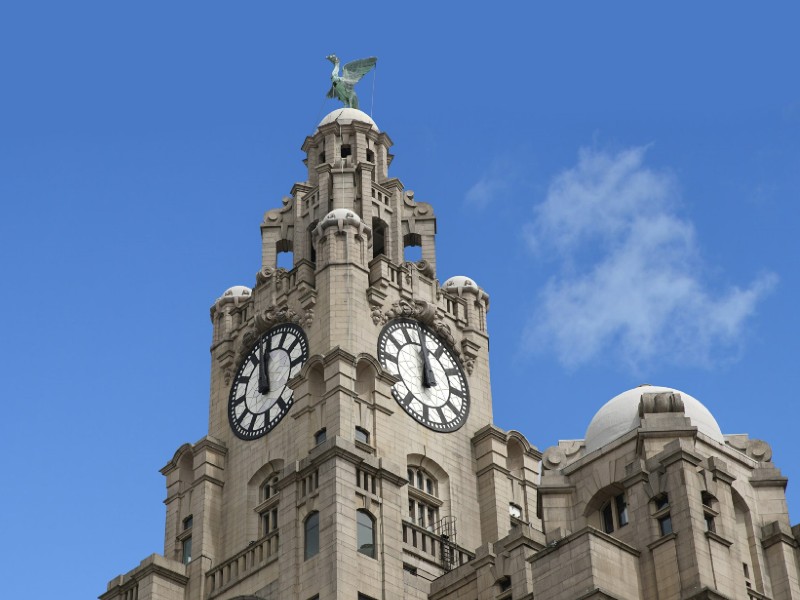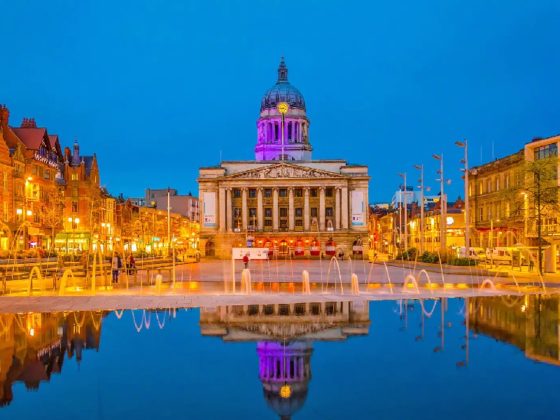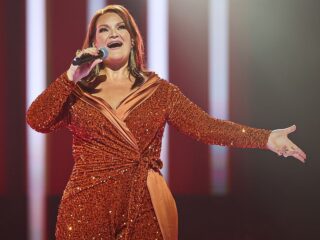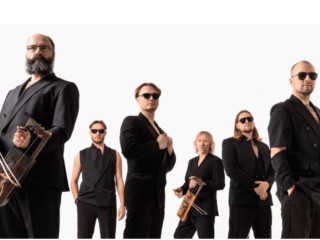Cities across the United Kingdom are throwing their hats in the ring to host Eurovision 2023. Liverpool, in North West England, is amongst them.
On Friday 17 June, Liverpool City Council officially announced its intent to bid to host Eurovision 2023 in the city, after the EBU determined the contest could not take place in Ukraine. And following official confirmation the UK will host Eurovision 2023, the race to be host city is on.
But before any decisions are made, we’re going up and down the country to take a look at all the potential host cities and venues. Without further ado, here’s 10 facts about Liverpool.
10 Facts about Liverpool: Eurovision 2023 host city bid
1. The home of The Beatles
The most iconic quartet in British history — John, Paul, George and Ringo — hails from Liverpool. The Beatles as we know them today were formed in city in the 1960s, playing gigs at the famous Cavern Club on Mathew Street and various small venues across what was then part of Lancashire. In 1963, the group launched their debut LP Please Please Me to roaring success, topping the British album charts. Thus, Beatlemania was born. The Liverpool lads went on to score 17 number one singles and 15 number one albums in the UK, plus 20 number one Billboard Hot 100 singles in the USA. They are widely regarded as one of the most influential music acts of all time, and are a proud part of Liverpool’s music history. The Beatles’ tracks “Penny Lane” and “Strawberry Fields Forever” are named after locations in the southern part of the city, which have since become popular tourist destinations.
View this post on Instagram
2. Liverpool is England’s only UNESCO City of Music
The Beatles aren’t Liverpool’s sole musical export. As the only UNESCO City of Music in England, Liverpool has been commended for its contributions to the musical arts. Liverpool homes a wealth of concert halls and music venues, encompassing genres and styles from around the world. The city’s annual Africa Oyé festival in the largest celebration of African music in the country, attracting over 50,000 people to Liverpool’s Sefton Park every June. Elsewhere, the city is the stomping grounds of many British music greats, including Cilla Black, Atomic Kitten, The Wombats, Elvis Costello, Echo & The Bunnymen, The Coral, and Melanie C of The Spice Girls.
Eurovision is an event that’s made for the city of Liverpool.
— Joanne Anderson (@MayorLpool) July 22, 2022
? UNESCO City of Music
? Home to The Beatles
? Arena capacity
? Hotel capacity
? A beautiful skyline
? Hospitality and culture
?? Well connected
Please VOTE for Liverpool: https://t.co/MsMQVRsJoA pic.twitter.com/vzmXlO2ev7
3. Liverpool is the most successful footballing city in the UK
Home of Liverpool and Everton football clubs, the city is known around the world for its sporting prowess. As of 2022, Liverpool FC has won 19 league titles, eight FA Cups, nine league cups, three UEFA Cups, four UEFA Super Cups and one FIFA World Club Cup. Meanwhile, Everton FC has won nine league titles, five FA Cups, one European Cup Winners’ Cup and nine Charity Shields. The famous rivalry between the two groups divides city-dwellers into two camps — the Reds (Liverpudlians) and the Blues (Evertonians), sometimes called the toffees. The rivalry coalesces at the seasonal Merseyside Derby, which sees both sides face off in their home city.
View this post on Instagram
4. Liverpool has connections with the Titanic
In 1845, a shipping and transportation company under the name White Star Line was founded in Liverpool. Through its years carrying passengers and cargo across the Atlantic and beyond, White Star Line became one of the most prominent shipping lines in the world. The Titanic, which infamously met her doom in 1912, was operated by White Star Line. Thus, Liverpool has a rich maritime history. Today, the survivors and some 1,500 victims of the Titanic sinking are remembered in a memorial at Liverpool’s Maritime Museum, located in the heart of the city’s dockyard.
View this post on Instagram
5. The Superlambanana reigns supreme
Every town and city in the UK has at least one statue or monument firmly embedded in local culture. Liverpool has two. Firstly, the iconic liver bird, found in the Liverpool Football Club logo and on top of the Royal Liver Building. But more intriguing is the obscure Superlambanana. The eight-tonne, five-metre, part-lamb, part-banana sculpture, standing proudly near Liverpool John Moores University, was designed by Japanese artist Taro Chiezo to represent two common cargos transiting through the ports of Liverpool. In 2008, during Liverpool’s run as the European Capital City of Culture, 125 smaller lambanana replicas with various unique designs were dotted around the city. Many of these were later auctioned off for charity, but some can still be seen in and around the city’s many museums. You’ll find miniature lambananas in gift shops across the city.
the only celebrity to never be problematic or involved in scandal is Lambanana pic.twitter.com/NUxFA58ORx
— iris (@piixietit2) July 5, 2020
6. The UK’s biggest celebration of African music and culture
Africa Oyé is the UK’s largest celebration of African music and culture. Hosted in Sefton Park, the festival attracts more than 50,000 visitors who flock to Liverpool from all over the country to watch new and upcoming musicians perform, take part in dance workshops, taste food and sample fashion from around the world. Africa Oyé 2022 saw performances from international superstars Eek-A-Mouse, Oumou Sangaré and Newen Afrobeat.
View this post on Instagram
7. Liverpool has strong cultural ties to Ireland
Liverpool owes much of its culture to its Irish neighbours. As the Great Famine ravaged through Ireland in the 1840s, some one million people died from disease and hunger. Around 1.5 million people fled the country, with hundreds of families crossing the Irish Sea to Liverpool with hopes of finding prosperity in England. The Irish labourers that settled in the city had a huge influence on its architectural, cultural, and socio-political landscape. The development of Liverpool’s docks, the distinct twang of the scouse Liverpudlian accent, and the city’s love for St Patrick’s Day can all be attributed to our Irish brethren. Nowadays, the Liverpool — Dublin flight takes just 45 minutes, making both cities popular destinations for Irish and British tourists.
8. Home of the International Slavery Museum
Regrettably, Liverpool played a key role in the transatlantic slave trade. In the 18th century, Liverpool was Britain’s main slaving port, with some 1.5 million Africans carried across the Atlantic in disgraceful conditions inside Liverpool ships between 1700 and 1809. Much of Liverpool’s wealth came from the slave trade, with local councillors, mayors and members of parliament profiting from the cruelty, all the while inflicting great pain on families held against their will. Sinister and unsettling, the events of the transatlantic slave trade are crucially important to the history of Liverpool. Exhibits documenting the untold stories of enslaved African families, plus calls to action supporting the Black Lives Matter movement and the abolition of modern slavery, can be found at the International Slavery Museum in the Liverpool docklands.
9. It’s home to the biggest clock face in the UK
The Royal Liver Building is one of Liverpool’s standout landmarks. The liver birds atop the building — one looking inwards towards the city and one looking outwards to the sea — are firmly embedded in Liverpudlian culture, with the design of a liver bird used in the insignia of Liverpool football club and local schools, college and universities. But the liver birds aren’t the only memorable thing about this astounding architectural work. At a diameter of 25ft, the Royal Liver Building clock face is the largest of its kind in the country. By comparison, London’s Elizabeth Tower (colloquially referred to as Big Ben) is 23ft in diameter.
View this post on Instagram
10. Liverpool has the biggest cathedral in Britain
Liverpool Anglican Cathedral is the largest cathedral in the UK, and at an external length of 189 metres, is the longest cathedral in the world. Construction of the majestic gothic revival building took 74 years, from 1904 to 1978. Providing stunning views of the city landscape from its tower, the cathedral attracts thousands of visitors from around the world every year. Throughout the year, Liverpool Anglican Cathedral hosts a full programme of events including dinners and galas, such as the National Diversity Awards and graduation ceremonies for local universities. Liverpool is also one of very few British cities with two cathedrals — the Metropolitan Cathedral on Hope Street serves as a hub for Liverpool’s Catholic population.
What do you think? Would you like to see Liverpool host Eurovision 2023? Let us know in the comments below.











Oliver, you are certainly very brave wading into the football debate like that!!
Liverpool would put on a good show, that’s for sure.
When do you think will we get the host city?
Well the bidding is just getting started , around a month later than RAI started their bidding phase. The UK has a lot of interested parties who only got certainty that theUK is going to host this week so city councils are not very far in their plans. Also I expect the BBC and UA will take their time with a lot of things to take into consideration like the plans of cities to incorporate the partly ukrainian identity of next years eurovision. Maybe somewhere around the end of October?
Typically around October, but it can vary. Before Turin was announced, we had little to no information about the bidding process between the early outs and the eventual selection of Turin. Whereas for the Netherlands, we knew the final choice was between Maastricht and Rotterdam.
Actually my favourite choice for host city. Amazing city and people, and very deserving choice. The Echo arena is slightly smaller than the average, but still ample room for a spectical. Surprised it hasn’t been mentioned here, but the same building has a large convention centre attached, perfect for dressing rooms, back of house, green room and press centre, all in one!
Maybe we could get Neil Buchanan from Art Attack to host the green room (or his band to play in the interval)